A New Approach to the Development of Geothermal Water Utilization in the Context of Identifying and Meeting the Social Needs of Local Communities: A Case Study from the Mogilno–Łódź Trough, Central Poland
Abstract
1. Introduction
2. Methodology
3. The Geothermal Water of the Mogilno–Łódz Trough
3.1. The Multifaceted Applications of Geothermal Waters in the Area of the Uniejów
3.2. The Poddębice Geothermal Heating Plant
3.3. Opportunities for Geothermal Development in the Malanów Region
4. Discussion—Social Aspects of the Use of Geothermal Waters
4.1. Ways of Using Geothermal Waters
- (1)
- mineral waters—waters containing at least 1000 mg of dissolved components per 1 dm3, including sodium, calcium, and magnesium chlorides, as well as sulphates and bicarbonates occurring in individual waters in various quantitative ratios. The characteristics of mineral water include the following: the percentage content of total solids dissolved in a given water, the names of anions and cations whose quantitative share in milligram equivalents (meq) in 1 dm3 of water exceeds 20% in the order of decreasing concentrations;
- (2)
- specific (slightly mineralized) waters—waters containing less than 1000 mg of dissolved solids per 1 dm3, including one or more specific medicinal components in the concentrations specified below or higher:
- (a)
- 1 mg of iodides—iodide water;
- (b)
- 1 mg of sulfides or other sulfur compounds (II)—sulfide water;
- (c)
- 2 mg of fluorides—fluoride water;
- (d)
- 10 mg of iron (II)—iron water;
- (e)
- 70 mg of metasilicic acid—silicon water;
- (f)
- 1000 mg of free carbon dioxide—acidulous water;
- (g)
- 250—999 mg of free carbon dioxide—carbonic acid water or
- (h)
- showing a temperature of at least 20 °C at the outflow from the intake—thermal water;
- (i)
- showing radioactive activity of at least 74 Bg/dm3—radon water.
- (3)
- specific mineral waters—mineral waters containing one or more specific components listed in point 2.
4.2. The Social Benefits of Using Geothermal Waters
4.3. Predicting Geothermal Energy Production for the Commerce and Public Service Sectors in Poland until 2030
5. Conclusions
Author Contributions
Funding
Institutional Review Board Statement
Informed Consent Statement
Data Availability Statement
Conflicts of Interest
References
- Dalla Longa, F.; Nogueira, L.P.; Limberger, J.; van Wees, J.-D.; van der Zwaan, B.; Fridleifsson, I.B. Geothermal energy for the benefit of the people worldwide. In Proceedings of the World Geothermal Congress, Tokyo, Japan, 28 May–10 June 2000. [Google Scholar]
- Limberger, J.; Calcagno, P.; Manzella, A.; Trumpy, E.; Boxem, T.; Pluymaekers, M.P.D.; van Wees, J.-D. Assessing the prospective resource base for enhanced geothermal systems in Europe. Geotherm. Energy Sci. 2014, 2, 55–71. [Google Scholar] [CrossRef]
- European Geothermal Energy Council (EGEC). Geothermal Market Report, Key Finding; European Geothermal Energy Council: Brussels, Belgium, 2020. [Google Scholar]
- Sowiżdżał, A. Geothermal energy resources in Poland—Overview of the current state of knowledge, 2018. Renew. Sustain. Energy Rev. 2018, 82, 4020–4027. [Google Scholar] [CrossRef]
- Kępińska, B. Przegląd stanu wykorzystania energii geotermalnej w Polsce w latach 2016–2018. Tech. Poszukiwań Geol. 2018, 57, 11–27. [Google Scholar]
- Kępińska, B. A review of geothermal energy uses in Poland in 2013–2015. Tech. Poszuk. Geologicznych. 2016, 55, 19–35. [Google Scholar]
- Hałaj, E. Kąpieliska i ośrodki wypoczynkowe na Podhalu i Niżu Polskim jako przykłady bezpośredniego wykorzystania wód geotermalnych w Polsce. Tech. Poszuk. Geologicznych. Geoterm. Zrównoważony Rozw. 2012, 51, 3–15. [Google Scholar]
- Hałaj, E. Geothermal bathing and recreation centres in Poland. Environ. Earth Sci. 2015, 74, 7497–7509. [Google Scholar] [CrossRef][Green Version]
- Górecki, W.; Sowiżdżał, A.; Hajto, M.; Wachowicz-Pyzik, A. Atlases of geothermal waters and energy resources in Poland. Environ. Earth Sci. 2015, 74, 7487–7495. [Google Scholar] [CrossRef]
- Górecki, W. Atlas Zasobów Geotermalnych na Niżu Polski; AGH KSE: Kraków, Poland, 2006. [Google Scholar]
- Górecki, W. Atlas Zasobów Energii Geotermalnej na Niżu Polskim; Towarzystwo Geosynoptyków GEOS: Kraków, Poland, 1995. [Google Scholar]
- Wachowicz-Pyzik, A. Ocena Geologicznych Uwarunkowań Inwestycji Geotermalnych Przy Wykorzystaniu Modelowania Numerycznego na Przykładzie Utworów Jury Dolnej W Niecce Szczecińsko-Mogileńsko-Łódzkiej. Ph.D. Thesis, AGH University of Science and Technology, Kraków, Poland, 2019; p. 203. [Google Scholar]
- Kobojek, E. Położenie fizykogeograficzne miasta i gminy Uniejów. Biul. Uniejowski 2012, 1, 9–22. [Google Scholar] [CrossRef]
- Sapińska-Śliwa, A.; Kurpik, J. Current management of water and geothermal heat in Uniejów. Tech. Poszuk. Geol. 2011, 50, 225–235. [Google Scholar]
- Sapińska-Śliwa, A. Udostępnianie wód termalnych w Uniejowie—Rys historyczny. Biul. Uniejowski 2012, 1, 63–77. [Google Scholar] [CrossRef]
- Halaj, E.; Kępińska, B. Conjunctive uses of the geothermal water resources from lower cretaceous formations in the Mogilno-Lodz Trough, Poland. Sustain. Water Resour. Manag. 2018, 5, 1479–1494. [Google Scholar] [CrossRef]
- Available online: https://energia-geotermalna.org.pl/geotermia-konin-sp-z-o-o/ (accessed on 29 October 2023).
- Bentkowski, A.; Biernat, H.; Kapuściński, J.; Posyniak, A. Dodatek do Dokumentacji Ustalającej Zasoby Eksploatacyjne Wód Termalnych z Utworów Kredy Dolnej Regionu Uniejowa Wraz z Określeniem Warunków Hydrogeologicznych w Związku z Wtłaczaniem Wód do Dolnokredowego Poziomu Wodonośnego; Przedsiębiorstwo Geologiczne POLGEOL S.A.: Warszawa, Poland, 2005. [Google Scholar]
- Kępińska, B.; Bujakowski, W.; Tomaszewska, B.; Pająk, T.; Bielec, B.; Banaś, J.; Pawlikowski, M.; Solarski, W.; Mazurkiewicz, B.; Miecznik, M. Wytyczne Projektowe Poprawy Chłonności w Związku z Zatłaczaniem Wód Termalnych w Polskich Zakładach Geotermalnych; Wyd; IGSMiE PAN, Geotermia Mazowiecka S.A.: Mszczonów, Poland, 2011. [Google Scholar]
- Bentkowski, A.; Biernat, H.; Bujakowska, K.; Kapuściński, J. Aneks do Dokumentacji Zasobów Wód Termalnych w Kategorii B i C z Utworów Kredy Dolnej Regionu Uniejowa; Przedsiębiorstwo Geologiczne POLGEOL S.A.: Warszawa, Poland, 2001. [Google Scholar]
- Available online: https://geotermia-uniejow.pl/ (accessed on 29 October 2023).
- Latour, T.; Smętkiewicz, K. Właściwości fizykochemiczne i chemiczne wód geotermalnych i ich zastosowanie lecznicze ze szczególnym uwzględnieniem wody z odwiertu PIG/AGH w Uniejowie. Biul. Uniejowski 2012, 1, 79–93. [Google Scholar] [CrossRef]
- Available online: https://kosmetykitermalne.pl/ (accessed on 29 October 2023).
- Sowiżdżał, A.; Hajto, M.; Hałaj, E. Thermal waters of central Poland: A case study from Mogilno–Łódź Trough, Poland. Environ. Earth Sci. 2020, 79, 112. [Google Scholar] [CrossRef]
- Sowiżdżał, A.; Chmielowska, A.; Tomaszewska, B.; Operacz, A.; Chowaniec, J. Could geothermal water and energy use improve living conditions? Environmental effects from Poland. Arch. Environ. Protect. 2019, 45, 109–118. [Google Scholar] [CrossRef]
- Cataldi, R.; Burgasi, P.D. From the mystery of Atlantis to the first integrated uses of geothermal energy. In Stories from a Heated Earth. Our Geothermal Heritage; GRC: Sacramento, CA, USA, 1999. [Google Scholar]
- Fridleifsson, I.B. Energy Requirements for the Next Millennium. In Proceedings of the Threshold: The United Nations and Global Governance in the New Millennium, Tokyo, Japan, 19–21 January 2000. [Google Scholar]
- Yang, W.J. Historical aspects of geothermal use in China. In Proceedings of the World Geothermal Congress, Florence, Italy, 18–31 May 1995. [Google Scholar]
- Kępińska, B. Wody geotermalne w rozwoju cywilizacji. In Atlas geotermalny na Niżu Polskim—Formacje mezozoiczne; Górecki, W., Ed.; AGH: Kraków, Poland, 2006. [Google Scholar]
- Lindal, B. Industrial and other applications of geothermal energy, except power production and district heating. In Geothermal Energy, Earth Sciences; Amstead, H.C.H., Ed.; UNESCO: Paris, France, 1973; Volume 12. [Google Scholar]
- Clark, C.E.; Harto, C.B.; Sullivan, J.L.; Wang, M.Q. Water Use in the Development and Operation of Geothermal Power Plants; Argonne National Laboratory: Lemont, IL, USA, 2010; p. 85. [Google Scholar]
- Lund, J. Direct Utilization of Geothermal Resources Worldwide. In Power Stations Using Locally Available Energy Sources; Geo-Heat Center, Oregon Institute of Technology: Klamath Falls, OR, USA, 2018; pp. 297–325. [Google Scholar]
- Paczyński, B.; Płochniewski, Z. Wody Mineralne i Lecznicze Polski. Państwowy Instytut Geologiczny; Państwowy Instytut Geologiczny: Wydawca, Poland, 1996; p. 108. [Google Scholar]
- Latour, T.; Drobnik, M. Właściwości biochemiczne wód geotermalnych rozpoznanych w Polsce określające sposób ich wykorzystania do celów leczniczych lub rekreacyjnych. Tech. Poszuk. Geol. 2016, 55, 67–74. [Google Scholar]
- Obwieszczenie Ministra Zdrowia. w Sprawie Ogłoszenia Jednolitego Tekstu Rozporządzenia Ministra Zdrowia w Sprawie Zakresu Badań Niezbędnych do Ustalenia Właściwości Leczniczych Naturalnych Surowców Leczniczych i Właściwości Leczniczych Klimatu, Kryteriów Ich Oceny Oraz Wzoru Świadectwa Potwierdzającego te Właściwości. 2018. Available online: https://isap.sejm.gov.pl/isap.nsf/download.xsp/WDU20180000605/O/D20180605.pdf (accessed on 29 October 2023).
- Tomaszewska, B. Pozyskanie wód przeznaczonych do spożycia oraz cieczy i substancji balneologicznych w procesie uzdatniania wód geotermalnych. Wyd. Igsmie Pan. 2018, 63, 1111–1114. [Google Scholar]
- Tomaszewska, B.; Tyszer, M. Assessment of the influence of temperature and pressure on the prediction of the precipitation of minerals during the desalination process. Desalination 2017, 424, 102–109. [Google Scholar] [CrossRef]
- Smętkiewicz, K.; Social Opinion on Geothermal Water’s Use on the Example of Residents and Visitors in Uniejów Health Resort. Technika Poszukiwań Geologicznych Geotermia, Zrównoważony Rozwój, No 1/2016. Available online: https://bibliotekanauki.pl/articles/203394 (accessed on 29 October 2023).
- Smętkiewicz, K. Świadomość Społeczna Wykorzystania Wód Geotermalnych w Województwie Łódzkim i Landzie Styrii w Kontekście Zrównoważonego Rozwoju Regionów; Wyd. Ibidem: Łódź, Poland, 2014. [Google Scholar]
- Borović, S.; Markov, I. Utilization and tourism valorisation of geothermal waters in Croatia. Renew. Sustain. Energy Rev. 2015, 44, 52–63. [Google Scholar] [CrossRef]
- Kurek, K.; Heijman, W.; van Ophem, J.; Gędek, S.; Strojny, J. Geothermal spas as a local development factor, the case of Poland. Geothermics 2015, 85, 101777. [Google Scholar] [CrossRef]
- Yasukawa, K.; Kubota, H.; Soma, N.; Noda, T. Integration of natural and social environment in the implementation of geothermal projects. Geothermics 2018, 73, 111–123. [Google Scholar] [CrossRef]
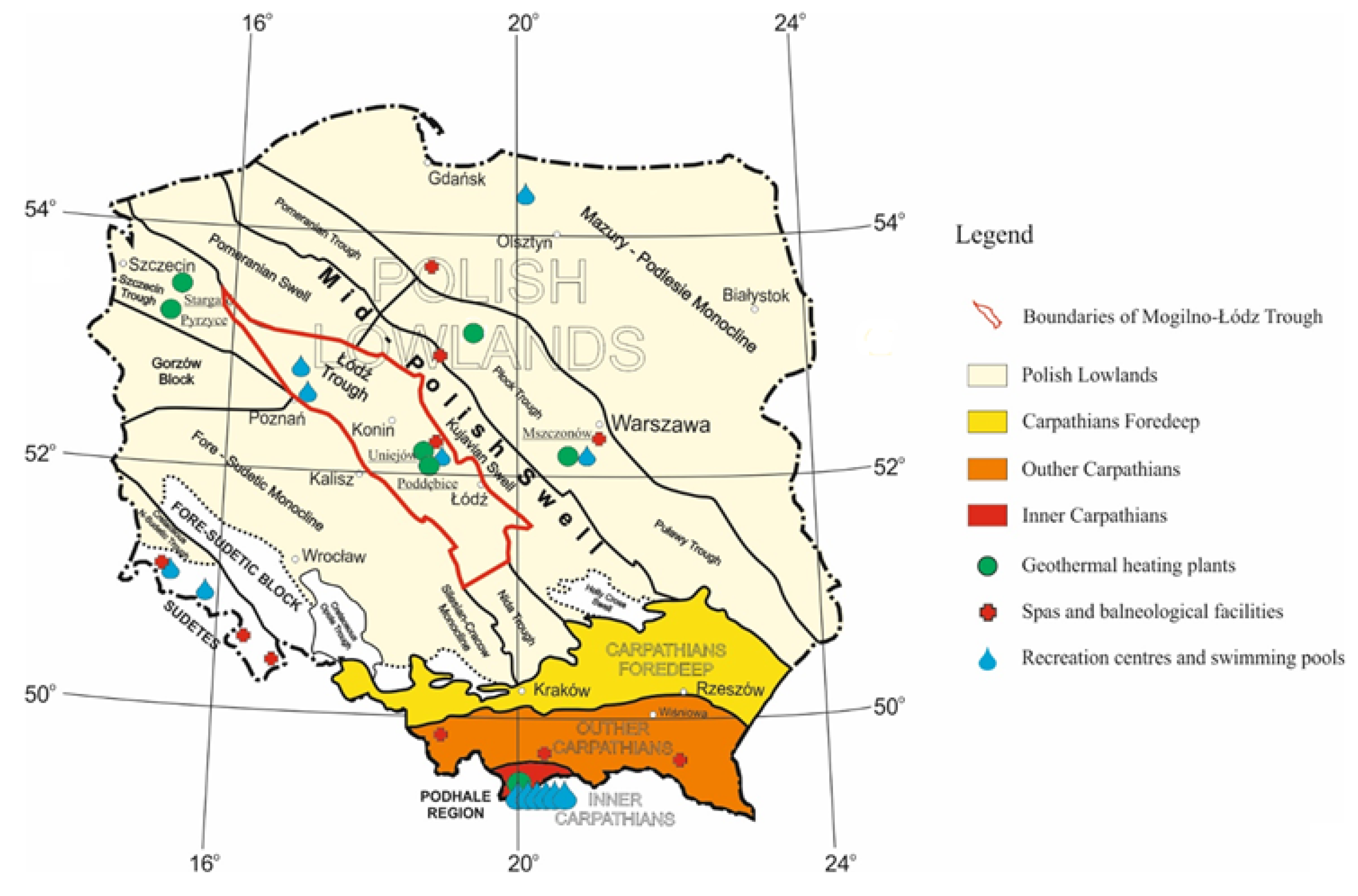
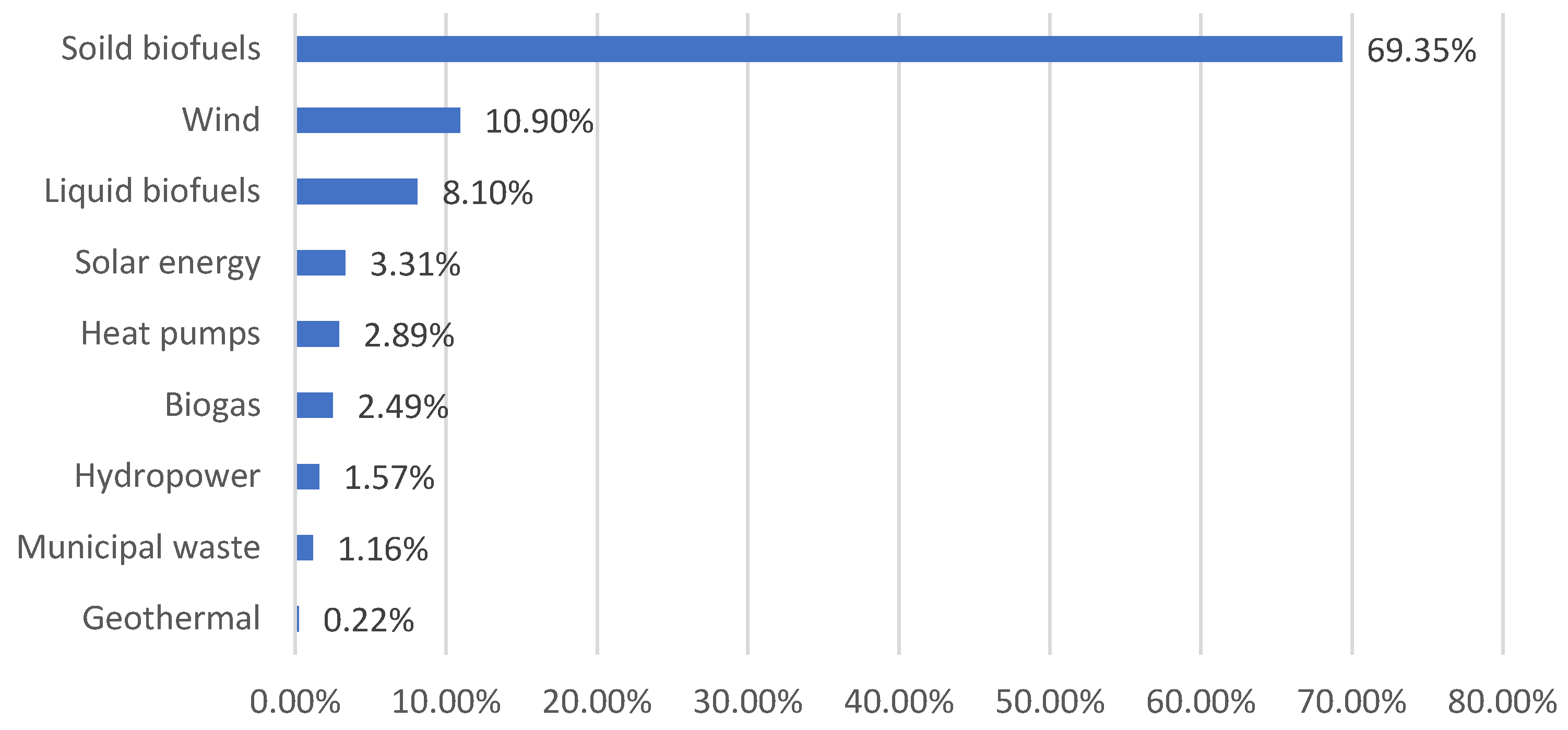
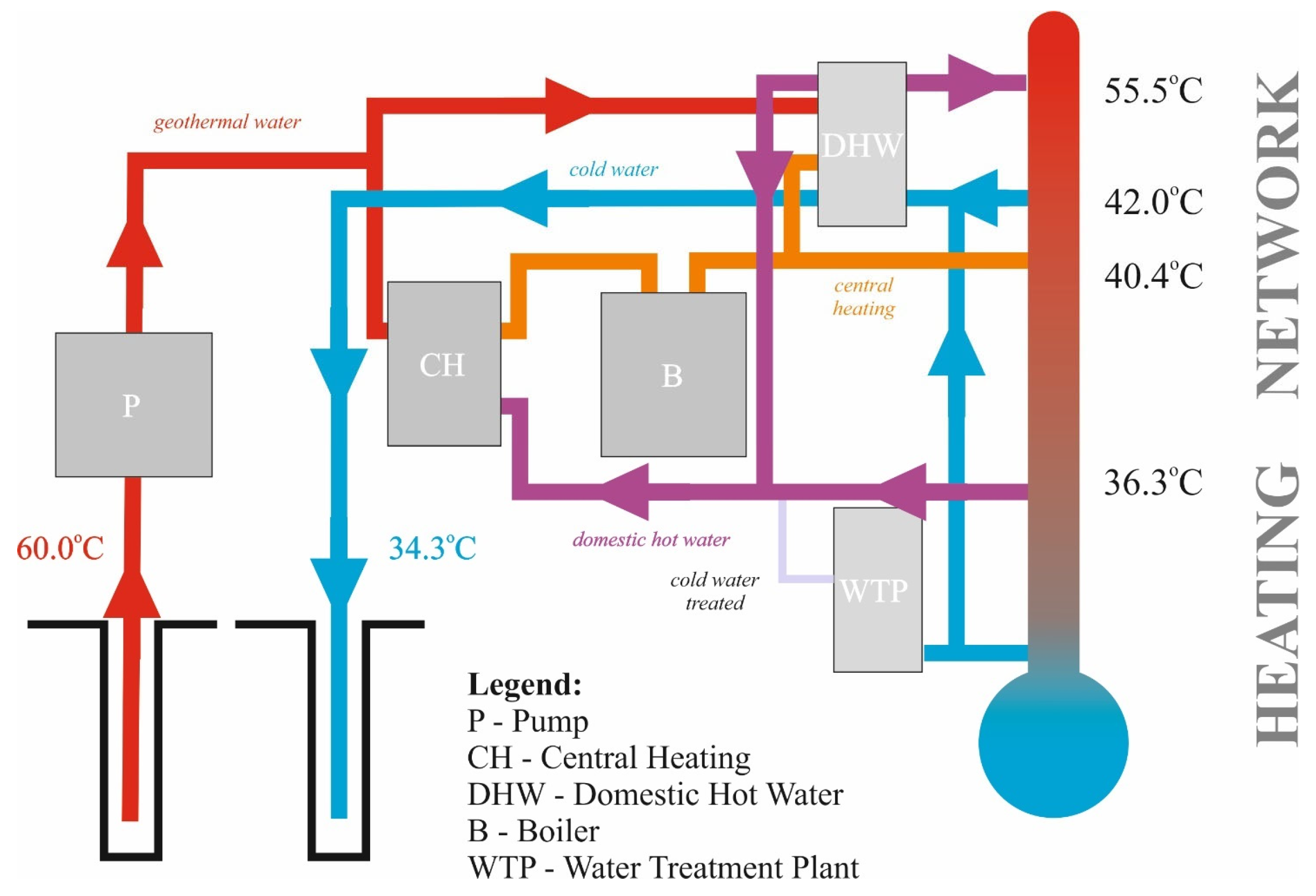
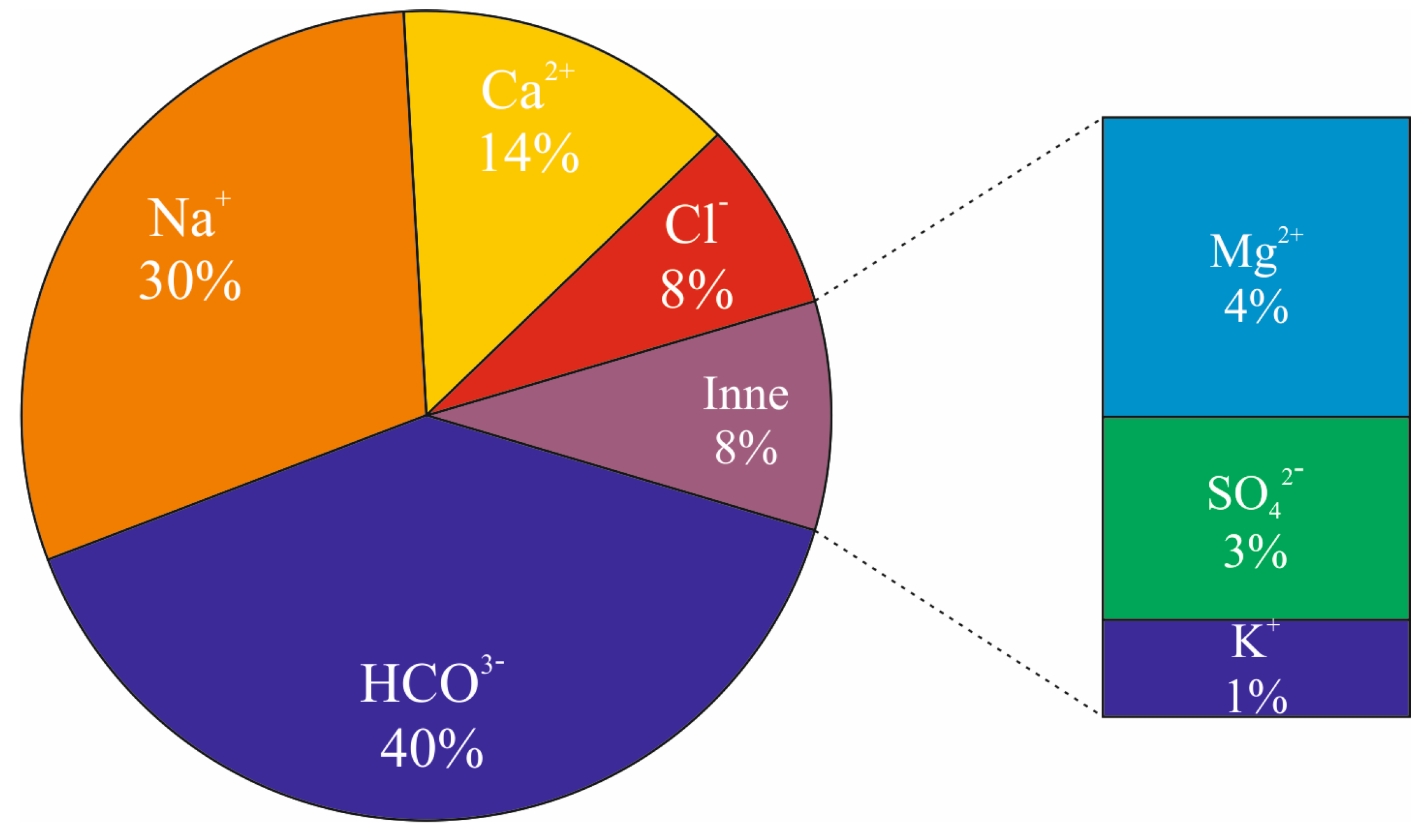

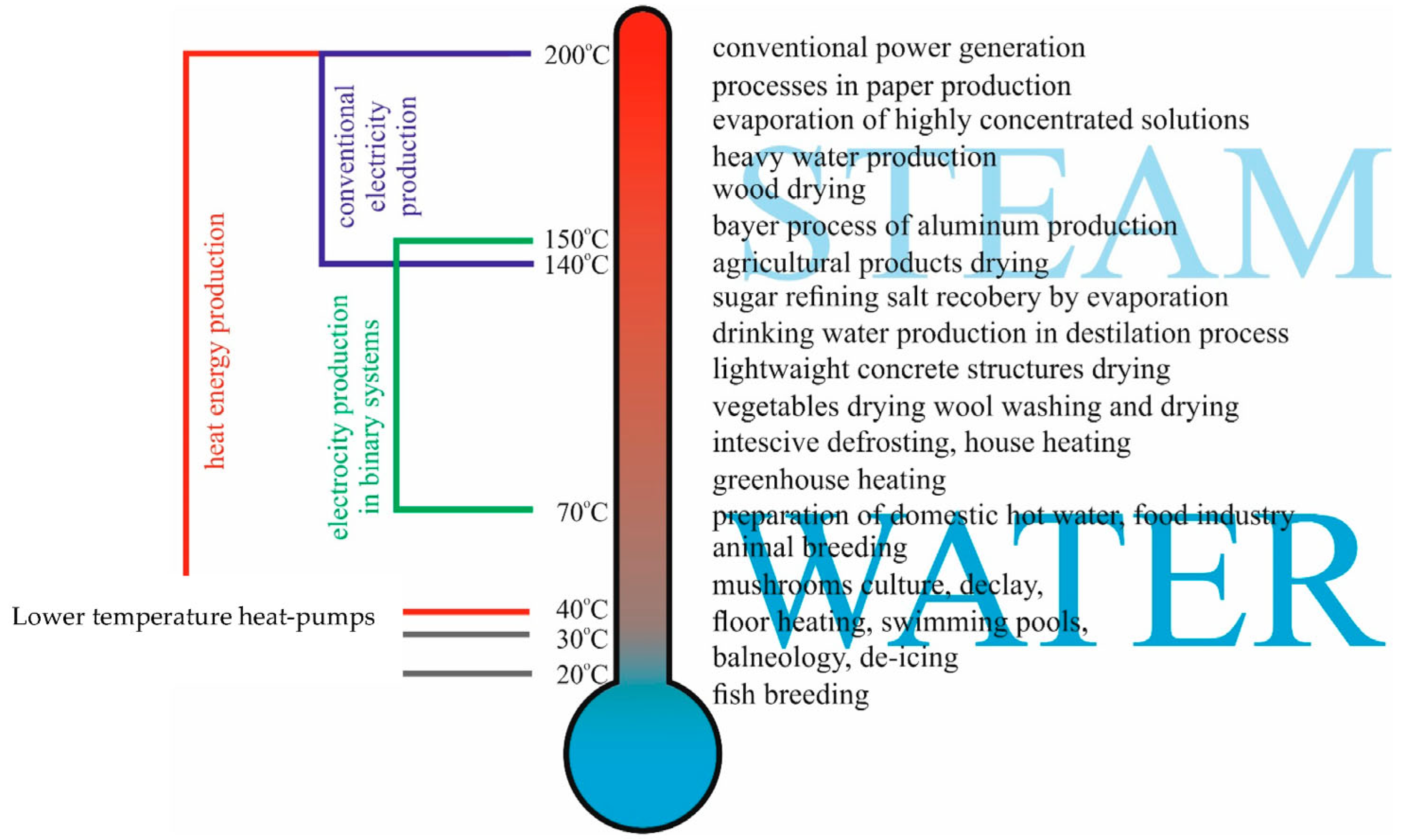
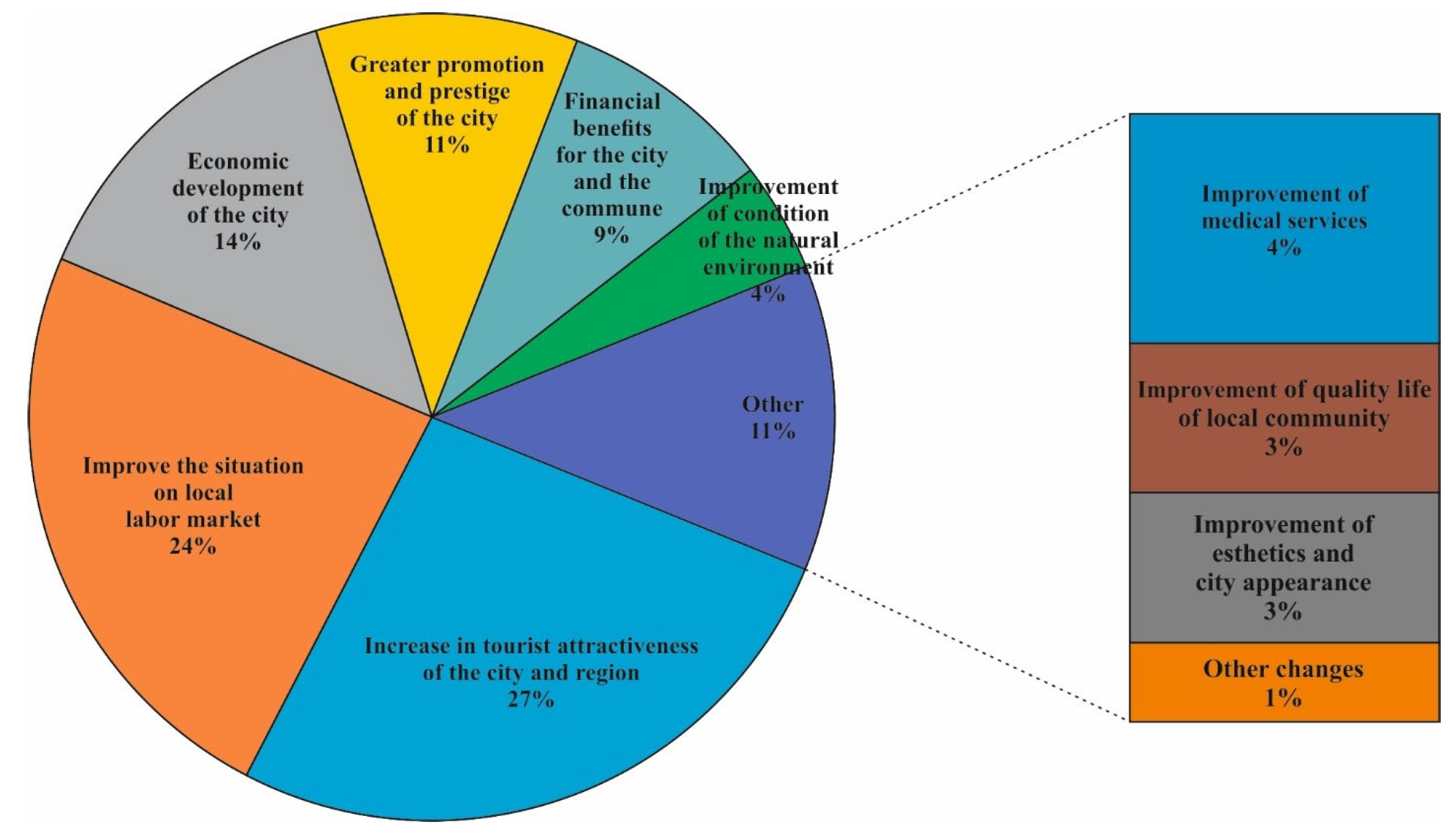
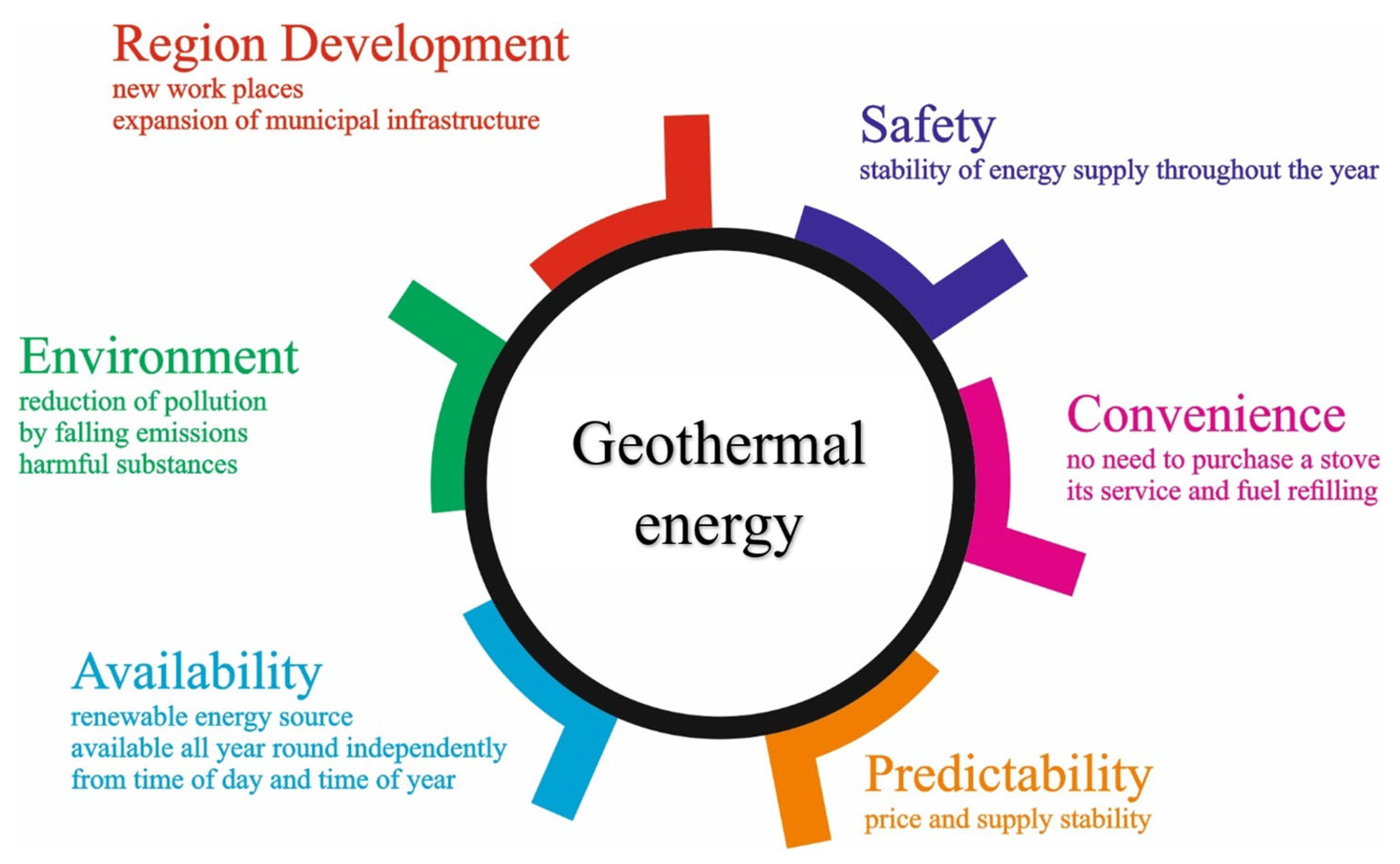


| Color [mg Pt] | 0 |
| Taste | Saline |
| Smell | Very weak oil |
| Water reaction [pH] | 7.20 (22 °C) |
| Temperature of water [°C] | 68 |
| Redox potential E [mV] | −51.9 (22 °C) |
| Conductivity [S/cm] | 12.06 × 10−3 |
| Absorption λ = 254 [nm] | 0.059 |
| Absorption λ = 436 [nm] | 0.005 |
| Horizon | Silt Content [-] | Effective Porosity [%] | Permeability [mD] |
|---|---|---|---|
| Toarcian | 0.45 | 6.5 | 44 |
| Pliensbachian | 0.32 | 10 | 120 |
| Sinemurian | 0.30 | 10 | 130 |
| Potential Well Capacity Value [m3/h] | ||
|---|---|---|
| Horizon | Min. | Max. |
| Toarcian | 5 | 80 |
| Pliensbachian | 10 | 120 |
| Sinemurian | 15 | 120 |
Disclaimer/Publisher’s Note: The statements, opinions and data contained in all publications are solely those of the individual author(s) and contributor(s) and not of MDPI and/or the editor(s). MDPI and/or the editor(s) disclaim responsibility for any injury to people or property resulting from any ideas, methods, instructions or products referred to in the content. |
© 2023 by the authors. Licensee MDPI, Basel, Switzerland. This article is an open access article distributed under the terms and conditions of the Creative Commons Attribution (CC BY) license (https://creativecommons.org/licenses/by/4.0/).
Share and Cite
Wachowicz-Pyzik, A.; Sowiżdżał, A.; Maćkowski, T.; Stefaniuk, M. A New Approach to the Development of Geothermal Water Utilization in the Context of Identifying and Meeting the Social Needs of Local Communities: A Case Study from the Mogilno–Łódź Trough, Central Poland. Sustainability 2024, 16, 37. https://doi.org/10.3390/su16010037
Wachowicz-Pyzik A, Sowiżdżał A, Maćkowski T, Stefaniuk M. A New Approach to the Development of Geothermal Water Utilization in the Context of Identifying and Meeting the Social Needs of Local Communities: A Case Study from the Mogilno–Łódź Trough, Central Poland. Sustainability. 2024; 16(1):37. https://doi.org/10.3390/su16010037
Chicago/Turabian StyleWachowicz-Pyzik, Anna, Anna Sowiżdżał, Tomasz Maćkowski, and Michał Stefaniuk. 2024. "A New Approach to the Development of Geothermal Water Utilization in the Context of Identifying and Meeting the Social Needs of Local Communities: A Case Study from the Mogilno–Łódź Trough, Central Poland" Sustainability 16, no. 1: 37. https://doi.org/10.3390/su16010037
APA StyleWachowicz-Pyzik, A., Sowiżdżał, A., Maćkowski, T., & Stefaniuk, M. (2024). A New Approach to the Development of Geothermal Water Utilization in the Context of Identifying and Meeting the Social Needs of Local Communities: A Case Study from the Mogilno–Łódź Trough, Central Poland. Sustainability, 16(1), 37. https://doi.org/10.3390/su16010037










